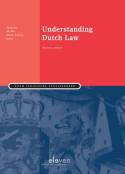Understanding Dutch Law
- ISBN: 9789462360143
- Editorial: Eleven International Publishing
- Fecha de la edición: 2020
- Lugar de la edición: The Hague. Países Bajos
- Edición número: 3rd ed.
- Encuadernación: Rústica
- Medidas: 23 cm
- Nº Pág.: 298
- Idiomas: Inglés

Each legal system has its peculiarities and the Dutch legal system is no exception. To understand a legal system profoundly, it is not enough to study its legal rules in isolation. In this book, the Dutch legal system is explained in relation to its values and cultural background. The basics of the main areas of law, constitutional, administrative, criminal and private law, are discussed in a clear and accessible manner. In addition, specific topics are introduced in which the connection between Dutch law and its culture and values are investigated in detail: legislation, family and labour law. The background of Dutch law is given depth with an introduction to the system as a whole, to legal history, and the court system. Throughout the book, the European context of the Dutch legal system is taken into consideration. The book can be used as an introduction to Dutch law for foreign students and others who are interested in the legal system of the Netherlands. Knowledge of law is useful but not a prerequisite for Understanding Dutch Law.
I GENERAL TOPICS 13
1 Introducing Dutch law 15
Sanne Taekema
1 Introduction 15
2 Dutch law as a European legal system 15
3 Sources of law 18
4 Dutch law in context 23
5 The structure of Dutch law and this book 28
2 A short overview of Dutch legal history 31
Raymond Kubben and Randall Lesaffer
1 Introduction 31
2 The later Middle Ages (1000-1400) 32
3 Personal union under the Burgundians and Habsburgs
(1400-1581) 36
4 The Dutch Republic 40
5 The Revolutionary era (1795-1813) 46
6 The Kingdom of the Netherlands (1813-present) 49
7 Conclusion 62
3 Dispute resolution inside and outside the courts 63
Annie de Roo
1 Dispute resolution 63
2 Dispute resolution inside the courts 64
3 Dispute resolution outside the courts 78
II PUBLIC LAW 89
4 Inhabiting legality
How the Dutch keep reconstructing their ‘Rechtsstaat’ 91
Willem J. Witteveen
1 Legality as an edifice 91
2 Foundations: the legal tradition and the republican heritage 93
3 The 18th century: liberal ideals 97
4 The 19th century: democratic institutions 105
5 The 20th century: social aspirations 111
6 Why the rechtsstaat is permanently under construction 114
7 Sagging floors of the rechtsstaat 118
5 Legislation in the Netherlands
Instrumentalist and interactionist approaches to law 125
Bart van Klink
1 The powers of the written word 125
2 The process of legislation 126
3 Legislation policy 138
4 New forms of regulation 145
5 The communicative turn and its critics 153
6 Dutch administrative law: the regent reigneth 157
Rob Jagtenberg
1 Introduction 157
2 Administrative law instruments 158
3 Judicial protection 160
4 Administrative litigation practice: a critique 165
5 Government: stepping back or taking control? 167
6 Concluding observations 173
7 Principles of Dutch criminal law 175
Sanne Taekema and Joost Nan
1 Introduction 175
2 The importance of legislation 177
3 Issues of substantive criminal law 179
4 Criminal procedure 183
5 Sanctions 190
6 Emancipation of the victim of a crime 193
III PRIVATE LAW 197
8 The outlines of Dutch private law 199
Harriët Schelhaas and Sanne Taekema
1 Introduction 199
2 The Dutch Civil Code 200
3 The open system of Dutch private law and the principle of
reasonableness and fairness 205
4 The broad scope of tort law 209
5 Contract law 216
6 Concluding remarks 229
9 Family law 231
Carinne Elion-Valter
1 Introduction 231
2 Features and principles of Dutch family law 232
3 Tendencies of family law 236
4 European and international family law 237
5 Name, nationality and gender 240
6 Affectionate relationships 243
7 Marital property relations 249
8 Divorce, separation and alimony 251
9 Affiliation 254
10 Adoption 258
11 Parental authority and joint authority 259
12 Succession law 263
13 Main features of Dutch succession law 265
14 Intestacy succession 267
15 Wills 270
16 Administration of the estate, transfer and partition 271
17 To conclude this chapter 272
10 The landscape of Dutch labor law 273
Annie de Roo
1 Introduction 273
2 Historical development of the Dutch labor relations system 274
3 Sources of Dutch labor law 276
4 Collective regulation of labor relations 277
5 The ‘life and death’ of a contract of employment 282
6 Concluding observations 288
Index 291







